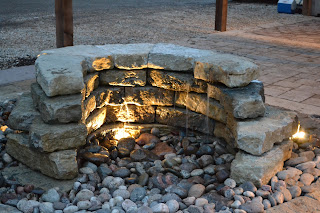There are lots different types of pools out there. Which one is right for you? It really depends on your space, your budget, your wants and needs. For right now, let's just skip over above ground pools. We are going to talk only about in-ground pools and spas.
We offer fiberglass pools and concrete pools (Gunite), as well as replacing vinyl liners. We also provide service for all pool types. If you currently have a pool but are thinking about renovation, give us a call! Our experienced builders can steer you in the right direction.
Fiberglass Pools
Fiberglass pools are pre-formed fiberglass shells. They are manufactured and then shipped to us. We dig the hole, install the pool, plumbing, coping and deck around the pool. Advantages of fiberglass pools include faster construction time, lower maintenance. Disadvantages include limited shapes and sizes- not customizable. However, as with the pool at left, the family chose to use stamped concrete as their decking and got to choose coping material. The shape was preformed but the material choices are individual. Higher cost than a vinyl liner but about the same as a basic concrete/ gunite pool.
Concrete Pool

Concrete pools are pools that are custom designed and dug to the homeowner's specifications. The shape is determined, the hole dug and the concrete is then applied (there are LOTS more steps but this is the short version). Gunite or Shotcrete is a new way of applying concrete vertically. When you are ready for the best, the backyard oasis, the whole package, you want a concrete pool. Every element is controlled by your choices. Want a spa? You got it. Want a water feature, a grotto, laminar that shoot from the center of the spa? Wand jets that create a mist all over your deck? You want a custom pool. Expect that your material choices and all the extras will obviously cost more money and take more time to create.
Vinyl Liners
Vinyl liner pools are inground pools with steel sides, usually a poured concrete bottom and a vinyl liner suctioned and affixed to the sides. The liners frequently have to be replaced- every 5-10 years. This is the lowest cost for the homeowner, but also the least permanent.

































